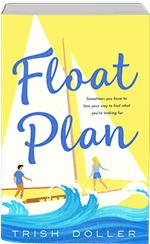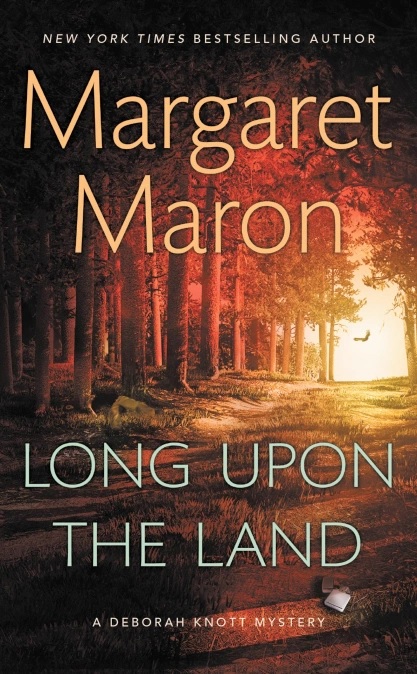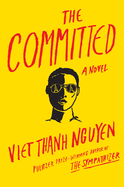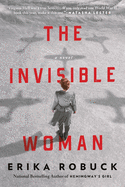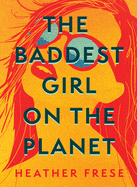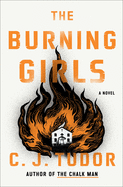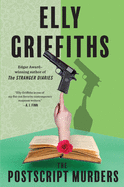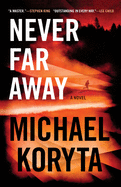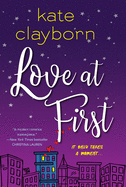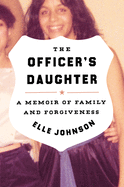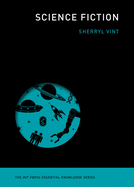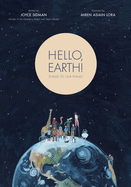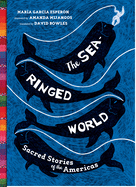 |
| (credit: Jesi Cason Photography) |
Trish Doller is the author of five young adult novels, including the critically acclaimed Something Like Normal. A former journalist, bookseller and radio personality, Doller lives in Florida with an opinionated herding dog and an ex-pirate. Float Plan, just published by St. Martin's Griffin, is her adult fiction debut.
Tell us about the inspiration behind Float Plan.
This book began about eight years ago, as a young adult novel that kind of went nowhere. The sailing piece came later, after we got our own boat. My husband and I have been sailing for as long as we've been together, and I've always wanted to read a book about a sailing "road trip." They always say, "Write the book you want to read." So I basically took this grain of a story from a YA novel and turned it into a novel about a woman who walks out of her own life.
Anna, the protagonist, is grieving her fiancé's death by suicide, though the book has a light tone overall. Can you talk about exploring her grief process this way?
I've done that in all of my books--I guess it's my style. My first novel was about a Marine coming home from Afghanistan and dealing with life after war. It has moments that will make you laugh and moments that will make you cry. I think that in anybody's life, you have these moments of deep sadness or grief or depression. But it's not all the time. There are moments when you're laughing and there are things that make you absolutely joyful.
The book begins a few months after Ben's death, so Anna is past the initial shock, but still very much in the thick of her grief.
Yes, I set it a little farther out from his death, so there's a point where Anna can walk out of her life. Immediately afterward, she just had to wade through this swamp of grief for a while. [When the book begins,] the grief is still real and raw, but she can recognize that she needs to do something to help herself heal.
In our culture, when someone we love is grieving, we want them to move past it. We want them to be happy again, and we want them to come out and do things with us. But how do you put a number on grief? Anna says, "No one gets to tell me how long I get to grieve." That's why I wanted her to have Keane: he knows exactly how it feels. Grief doesn't move in a linear way. It folds back on itself, and it trips over itself.
Keane is an experienced sailor who is dealing with a disability. Tell us about including him and treating his disability in the novel.
He was the original love interest in the YA novel that started this whole thing. He was 19 at the time--he liked to drink a lot, liked picking up girls. But I could tell, he was a good guy on the inside. When I started writing Float Plan as an adult novel, I wondered: What would he be like if he were 10 years older? What has he gone through? What has pushed him to be a better person? And I came across the story of a soldier who had been in an IED explosion in Afghanistan or Iraq and lost his leg, and he was an avid snowboarder. He had special prosthetics made so he could get back out there on the slopes. His experience helped inspire Keane's story.
Anna is surprised to find a kind of community in the sailing world.
Yes. One of the things I've learned in having boats and meeting boat people is that people make boat cards. They're like business cards, so you can keep up with people and kind of sail together. People will anchor near each other and meet near sunset for drinks. I could have delved more into that aspect, but the story was really about Anna's journey. She is so steeped in grief that she doesn't realize it, but she does have a quiet endurance that builds through the whole book. She's strong enough to handle this: both life without Ben and sailing the Caribbean alone.
How did you hammer out the details of Anna and Keane's journey?
That was tricky, because a lot of things are similar from island to island. It was really difficult to pick and choose. I wondered how to make the characters stop at a lot of islands and still have a unique experience. When Anna starts out, it's really not about the journey for her. It is about the destination. She just wants to do this thing.
The recent hurricanes in the Caribbean have also affected my writing. In previous versions of the book, Anna went to different islands. In one version, Keane and his brother go to Mass at a church that doesn't exist anymore. I kept changing things, but my editor and I finally decided--you have to find that middle ground between idealism and realism.
I also had to find the balance between sailing as a romantic thing and a realistic thing. On a boat, things break constantly. Experienced sailors might read this book and think it's not realistic, because things don't break often enough! Anna, when she leaves Miami, is literally me--I'm still learning and so is she. I wouldn't know if all the sails were trimmed correctly. But there are so many people who just buy boats and learn.
Have you visited the places Anna and Keane visit together?
I am fascinated by the Caribbean. I've been to Grenada, the Grenadines and Martinique, and now the doors are blown off. I just want to go everywhere. I love the people, and all the things there are to see and do.
My husband and I own a boat that is a smaller version of the one in the book. When I was drafting the book, we used the Alberg 30, and then we found one and bought it. We were going to outfit a boat and go sailing in the Caribbean, but we realized the boat was too small! We realized that we'd made this five-year plan, and we should maybe go to the Caribbean first to see if we liked it. So we flew to Grenada and spent a week there. I fell head over heels in love.
We have two boats now: the Alberg I mentioned, which we ended up calling Lorelei. We're German, and I wanted a mermaid-related name. The other boat--it's not beautiful. It is very functional, and it has all the things we need to do a serious sailing trip in the Caribbean. We named that boat Aroha, which is a Polynesian word that encompasses all the meanings of love. Compassion and kindness and love: that's how we want to be seen when we're out in the world. We want to leave a place knowing that when we come back, we will be welcomed. --Katie Noah Gibson
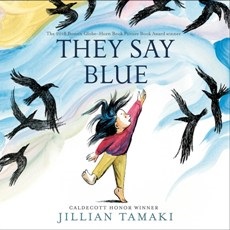 Jillian Tamaki's They Say Blue is a 2018 picture book available now in board book format ($9.99, Abrams). The thick paper of the book makes Tamaki's swirls of color almost tangible, nearly begging pre-readers to reach out and trace their fingers over the lines of fields of grass that look "like a golden ocean." While the illustrations invite activity, the text soothes, allowing this book to work perfectly for both story time and bed.
Jillian Tamaki's They Say Blue is a 2018 picture book available now in board book format ($9.99, Abrams). The thick paper of the book makes Tamaki's swirls of color almost tangible, nearly begging pre-readers to reach out and trace their fingers over the lines of fields of grass that look "like a golden ocean." While the illustrations invite activity, the text soothes, allowing this book to work perfectly for both story time and bed.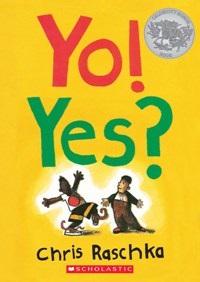 Yo! Yes?, Chris Raschka's 1994 Caldecott Honor book, became available as a board book in 2020 ($7.99, Cartwheel/ Scholastic). A breakout book for its time, Yo! Yes? has plenty of value for contemporary young readers as it brings two children together in friendship. Raschka's use of spare text and the literal boundary of the gutter act as excellent visual tools for those just learning to read.
Yo! Yes?, Chris Raschka's 1994 Caldecott Honor book, became available as a board book in 2020 ($7.99, Cartwheel/ Scholastic). A breakout book for its time, Yo! Yes? has plenty of value for contemporary young readers as it brings two children together in friendship. Raschka's use of spare text and the literal boundary of the gutter act as excellent visual tools for those just learning to read.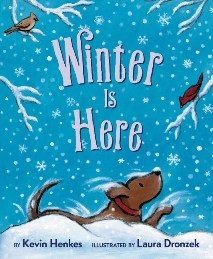 Kevin Henkes and Laura Dronzek's 2018 picture book Winter Is Here, featuring a curious pup and his child, received its own board book edition in 2019 ($8.99, Greenwillow). Considering it is the very beginning of March, Winter Is Here is the perfect board book to read to little ones living in climates where they experience seasons. It highlights all the joys of winter, especially at a time when it seems to be never ending: "Winter comes and then it stays/ and stays and stays." A calming blue palette and lean text make this an excellent book to read in the comforting circle of caregiver and child. --Siân Gaetano, children's and YA editor, Shelf Awareness
Kevin Henkes and Laura Dronzek's 2018 picture book Winter Is Here, featuring a curious pup and his child, received its own board book edition in 2019 ($8.99, Greenwillow). Considering it is the very beginning of March, Winter Is Here is the perfect board book to read to little ones living in climates where they experience seasons. It highlights all the joys of winter, especially at a time when it seems to be never ending: "Winter comes and then it stays/ and stays and stays." A calming blue palette and lean text make this an excellent book to read in the comforting circle of caregiver and child. --Siân Gaetano, children's and YA editor, Shelf Awareness


